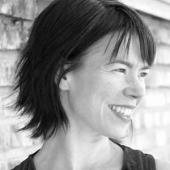What moves you?
Editorial
There are dances that come to me in dreams. Their tiny spines are just discernable through layers of transparent material. Sometimes they’ll develop enough to be born onto a stage, and sometimes they exist and recede during the course of a night’s sleep. No one knows but me. This is New Work. I swear it.
I think I’ve been moving toward New Work since the beginning. . .
It was pretty clear to me from the age of eleven that though I am a talented and capable dancer, my proficiencies do not abound in the classical arena. I do not have much turn-out or extension, absolute necessities. This lack of facility renders me less interested in the classical repertoire. I devote what gifts I do have to the creation of New Work. Choreographers use me for what they will; I am their raw material. I may not get my legs much higher than 90 degrees, but I will sweat and roll around on the floor and slap into another dancer and ride the momentum of that into places unknown.
Let me make my bias clear: I think dance is the cat’s meow. I think dance has the power to move people beyond what’s possible with words. In the language of the limbs, the common man resides in every gesture. Understanding is therefore contained in all of us. Yes, dance gets pretty esoteric, like when classical ballet is so full of ease that folks have a hard time identifying with the humanity behind it. But, at its core, dance is a boiling down of human experience to an essence all of us can smell.
New Work is a loaded concept in the arts, perhaps most particularly in dance. Dancers’ bodies, our personhoods, are our means of expression. As we change as people, so do the dances we dance, even the old ones. The hope becomes that onlookers see with new eyes every time and that dancers dance with new legs and new hearts, every time.
During these fifteen years with James Sewell Ballet, I’ve spent a lot of time keeping dances fresh for myself. I’ve performed the same dance for several seasons running countless times. Some dances are remounted every year, so it is imperative that I uncover the vitality within that same old dance. I am discovering that as I am different every day, my approach to any given dance is too. My dancing, like my person, is ever-changing. Dancing dances changes me. I am different for having danced them. When I approach a dance again I enter from a new window.
Thus one of my greatest joys has become witnessing a dance over time. For whole seasons I am privy to its evolution. It is a live thing, made up of organic matter (us) and sincere intention. New dancers dance it, and the work is newer for it, alive and ephemeral as ever.
And, as a contemporary ballet practitioner and New Work creator, I reference, rely on, am tethered to the classical syllabus, most especially when I’m diverging from it. I need to know from what I am diverging. I must be somewhere to go somewhere. And so it follows that every step, every gesture, contains a history. My new step contains all the arms and all the legs that ever executed anything similar.
So, New Work will likely be viewed in relationship to Old. Sometimes New Work makes its references clear. We can see the time-line. We know where we are historically and understand what we’re seeing. And then there’s New Work that is devoutly so itself it compels us to wonder: Where did this come from? What am I seeing? How did this get here? Work like this doesn’t need to reference anything; its own context is enough. Its vocabulary is freshly minted and of a new denomination.
Recently my step-dad emailed me a YouTube video. Mind you, I am not a YouTube devotee. Technology intimidates me and most times has me running the other direction to do something tangible like sew up a new pair of pointe shoes. I want my art live and in person. But given that it came from the person who put me through dancing school, I clicked the link.
Up pops some European train station where suddenly over the loud speaker Julie Andrews starts to sing. One by one folks begin dancing, and soon a load of school kids pours down the steps to join the proceedings in perfect unison. I watched with tears in my eyes as I thought about the great effort required to assemble this ensemble of children and adults of all colors, shapes and sizes. The impact on the crowd was something to behold as they too began to groove and clap along. By the end they were cheering, caught up in the contagion of the dance. I would argue that this is New Work too. It’s on my laptop, and despite my reticence, I am moved.
New Work in all its manifestations shatters me. Whether its mine, yours or an anonymous video artist’s, my heart pulls with pride at the human race evolving. Soon we will have four legs and two hearts to keep up with it all.
Remember that dream? The one where he fell into her, and that dance ensued that time? That’s what I’m talking about. That’s what I’m living for: to enter into a non-censored, creative, imaginative headspace where the laws of physics do not apply and where my tethers release. Because as much as I love, love the Old, I am ready to let go.




